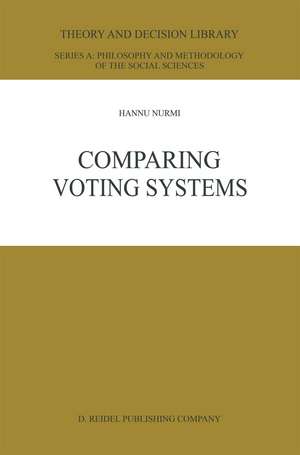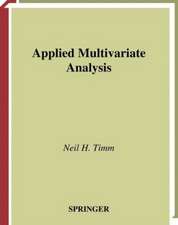Comparing Voting Systems: Theory and Decision Library A:, cartea 3
Autor Hannu Nurmien Limba Engleză Hardback – 31 oct 1987
| Toate formatele și edițiile | Preț | Express |
|---|---|---|
| Paperback (1) | 636.80 lei 6-8 săpt. | |
| SPRINGER NETHERLANDS – oct 2011 | 636.80 lei 6-8 săpt. | |
| Hardback (1) | 643.84 lei 6-8 săpt. | |
| SPRINGER NETHERLANDS – 31 oct 1987 | 643.84 lei 6-8 săpt. |
Din seria Theory and Decision Library A:
- 18%
 Preț: 952.40 lei
Preț: 952.40 lei -
 Preț: 382.57 lei
Preț: 382.57 lei - 18%
 Preț: 958.25 lei
Preț: 958.25 lei - 18%
 Preț: 949.23 lei
Preț: 949.23 lei - 18%
 Preț: 1232.09 lei
Preț: 1232.09 lei - 15%
 Preț: 643.34 lei
Preț: 643.34 lei - 18%
 Preț: 948.92 lei
Preț: 948.92 lei - 15%
 Preț: 581.79 lei
Preț: 581.79 lei - 15%
 Preț: 644.49 lei
Preț: 644.49 lei - 15%
 Preț: 642.83 lei
Preț: 642.83 lei -
 Preț: 389.70 lei
Preț: 389.70 lei - 18%
 Preț: 947.67 lei
Preț: 947.67 lei - 15%
 Preț: 641.20 lei
Preț: 641.20 lei -
 Preț: 388.90 lei
Preț: 388.90 lei - 15%
 Preț: 640.37 lei
Preț: 640.37 lei - 18%
 Preț: 952.26 lei
Preț: 952.26 lei - 15%
 Preț: 641.20 lei
Preț: 641.20 lei - 18%
 Preț: 953.35 lei
Preț: 953.35 lei - 18%
 Preț: 952.89 lei
Preț: 952.89 lei - 18%
 Preț: 951.47 lei
Preț: 951.47 lei - 15%
 Preț: 636.94 lei
Preț: 636.94 lei - 18%
 Preț: 944.82 lei
Preț: 944.82 lei - 18%
 Preț: 1383.81 lei
Preț: 1383.81 lei - 18%
 Preț: 1331.51 lei
Preț: 1331.51 lei - 20%
 Preț: 641.99 lei
Preț: 641.99 lei - 15%
 Preț: 647.40 lei
Preț: 647.40 lei
Preț: 643.84 lei
Preț vechi: 757.46 lei
-15% Nou
Puncte Express: 966
Preț estimativ în valută:
123.20€ • 128.89$ • 102.34£
123.20€ • 128.89$ • 102.34£
Carte tipărită la comandă
Livrare economică 02-16 aprilie
Preluare comenzi: 021 569.72.76
Specificații
ISBN-13: 9789027726001
ISBN-10: 9027726000
Pagini: 224
Ilustrații: X, 209 p.
Dimensiuni: 156 x 234 x 18 mm
Greutate: 0.51 kg
Ediția:1987
Editura: SPRINGER NETHERLANDS
Colecția Springer
Seria Theory and Decision Library A:
Locul publicării:Dordrecht, Netherlands
ISBN-10: 9027726000
Pagini: 224
Ilustrații: X, 209 p.
Dimensiuni: 156 x 234 x 18 mm
Greutate: 0.51 kg
Ediția:1987
Editura: SPRINGER NETHERLANDS
Colecția Springer
Seria Theory and Decision Library A:
Locul publicării:Dordrecht, Netherlands
Public țintă
ResearchCuprins
1. Introduction.- 2. Preliminaries.- 3. Social Welfare Function, Social Choice Function and Voting Procedures.- 4. First Problem: Cyclic Majorities.- 4.1. The Condorcet paradox.- 4.2. How to conceal the problem: the amendment procedure.- 4.3. How common are the cycles.- 4.4. Solutions based on ordinal preferences.- 4.5. Solution based on scoring function: the Borda count.- 4.6. More general majority cycles.- 5. Second Problem: How to Satisfy the Condorcet Criteria.- 5.1. Condorcet criteria.- 5.2. Some complete successes.- 5.3. Some partial successes.- 5.4. Complete failures.- 5.5. Some probability considerations and the plausibility of the Condorcet criteria.- 5.6. The majority winning criterion.- 6. Third Problem: How the Avoid Perverse Response to Changes in Individual Opinions.- 6.1. Monotonicity and related concepts.- 6.2. Successes.- 6.3. Failures.- 6.4. The relevance of the monotonicity criteria.- 7. Fourth Problem: How to Honour Unanimous Preferences.- 7.1. Unanimity and Paretoconditions.- 7.2. Successes.- 7.3. A partial failure and a total failure.- 7.4 Relevance and compatibility with other criteria.- 8. Fifth Problem: How to Make Consistent Choices.- 8.1. Choice set invariance criteria.- 8.2. Performances with respect to consistency.- 8.3. Performances with respect to WARP and PI.- 8.4. The relevance of the criteria.- 9. Sixth Problem: How to Encourage the Sincere Revelation of Preferences.- 9.1. Manipulability.- 9.2. Performance with respect to manipulability.- 9.3. The difficulty of manipulation.- 9.4. Agenda-manipulability.- 9.5. Sincere truncation of preferences.- 10. Social Choice Methods Based on More detailed information about Individual Preferences.- 10.1. The von Neumann-Morgenstern utility and classes of interpersonal comparability.- 10.2. Old and new methods.- 10.3. An assessment.- 11. Asking for Less Than Individual Preference Orderings.- 11.1. Constructing a social preference order for a subset of alternatives.- 11.2. Results based on individual choice functions.- 12. Why Is There So Much Stability and How Can We Get More of It?.- 12.1. Explanations of stability.- 12.2. Improving the performance of the voting procedures.- 13. From Committees to Elections.- 13.1. Proportional and majoritarian systems.- 13.2. Criteria for proportional systems.- 13.3. Voting power.- 14. Conclusions.- Name Index.
















